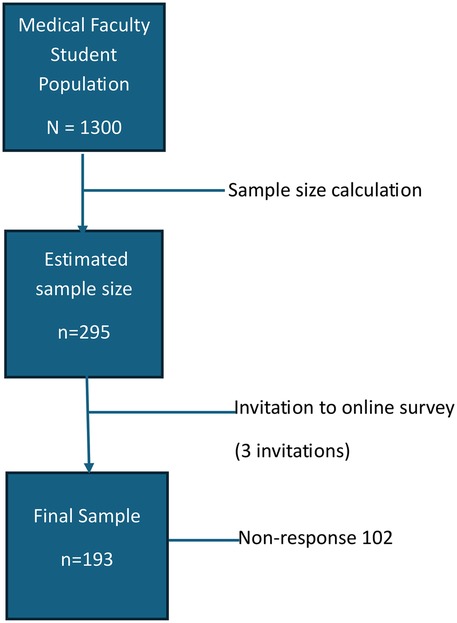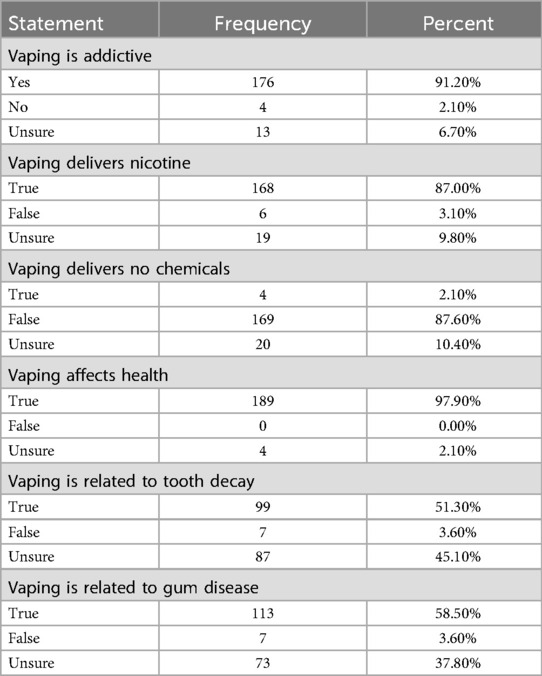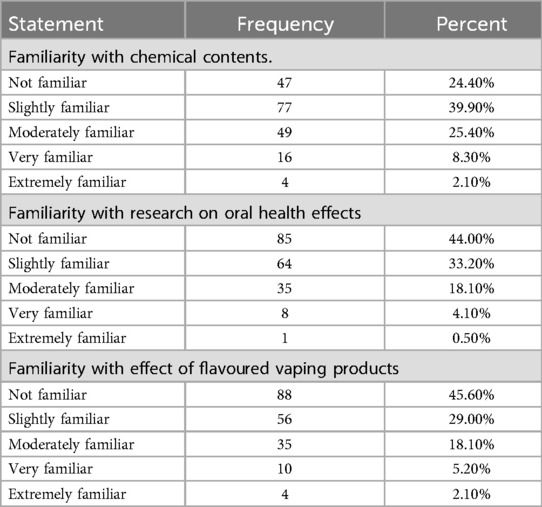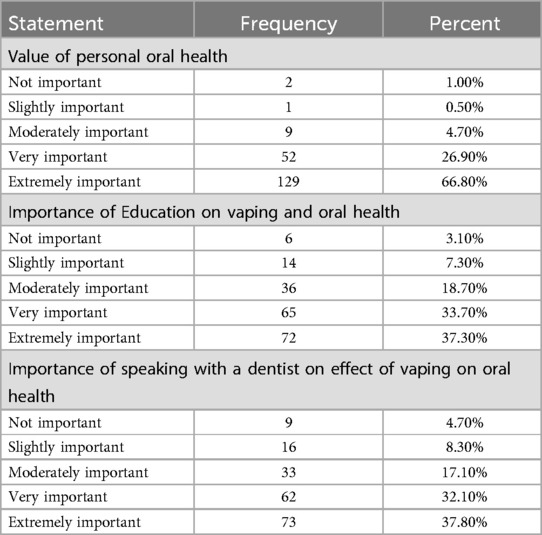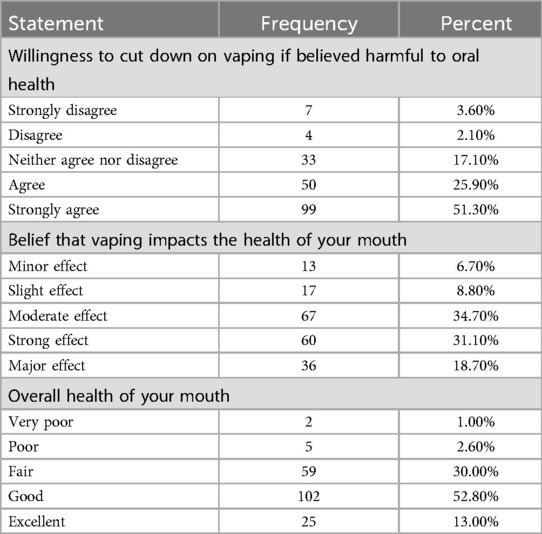- The School of Dentistry, Faculty of Medical Sciences, The University of the West Indies, St. Augustine, Trinidad and Tobago
Background: Electronic cigarette (e-cigarette) use has become more common among younger age groups around the world. Health concerns, including oral health effects have been reported.
Objective: This research aimed to assess prevalence of e-cigarette use and knowledge of oral health effects among young university students in Trinidad and Tobago and implications for oral health promotion.
Methods: A sample of 193 students, >18 years old, consisting of health sciences students from the Faculty of Medical Sciences, the University of the West Indies. Participants completed an online self-administered questionnaire including demographics, e-cigarette use habits and effect on oral health.
Results: The majority were female participation (75.1%). Age range of participants was 19 to 25-years-old, mean age 22 years old. 15% of participants currently used e-cigarettes. Most participants believed that e-cigarette use affects health (97.9%), is possibly addictive (91.2%), delivers nicotine (87%) and contains chemicals (87.6%). 51.3% believed that e-cigarette use, related to tooth decay and 58.5% gum disease. 44% of participants were not familiar with research on e-cigarette use and its effects on oral health. Most participants thought the information on e-cigarettes was important (78.3%) and (71.5%) would speak to a dentist about its effects on oral health. 76% of participants indicated willingness to quit e-cigarette use if adverse oral health effects were understood.
Conclusion: Among this sample of health sciences students, e-cigarette use was low. There was limited knowledge of its effects on oral health. Adverse effects of e-cigarette use on oral health should be included in oral health promotion initiatives.
Introduction
Electronic cigarette (e-cigarette) use has become a popular trend and marketed as a safer alternative for nicotine delivery compared to traditional tobacco smoking since its inception almost twenty years ago (1). These products are also known as vapes, vape pens, e-cigars, electronic hookahs and pod systems, can be categorized as Electronic Nicotine Delivery Systems and Electronic Non-Nicotine Delivery Systems (ENDS and ENNDS) depending on if they contain nicotine or not along with other components such as chemical additives and flavourings which, when heated produce aerosols that are inhaled (2, 3). The enticing flavours, sleek design and the perception that it is less harmful than conventional tobacco products have attracted much of the younger population worldwide (2–4). However, there is emerging evidence that highlights the potential negative health effects these e-cigarettes pose, including oral health effects (3). Initially e-cigarettes have been used to help tobacco smokers gradually quit smoking as they were marketed as a healthier alternative and for this reason they gained popularity (5–7). Exposure to components of e-cigarettes may have health effects (1, 8). Research has shown a link between e-cigarette use and e-cigarette or vaping product use-related-associated lung injury (EVALI), a form of acute lung injury (9, 10).
Research has found negative effects on oral health caused by e-cigarettes. These included increased risk of periodontal disease, tooth and bone loss, and hard and soft tissue lesions in the oral cavity (1, 3). The most common effects reported by the World Dental Federation (FDI), were mouth and throat irritation and periodontal damage (11). Survey data from the US showed that e-cigarette use is prevalent among the young age-groups particularly those in middle and high school (12). Other countries in Europe, Asia and Africa have reported its prevalence and proposed legislation on its use and sale to persons under 18-years old (13). In the Caribbean region the available on the prevalence of e-cigarette use suggests an increase in younger age group (14, 15). According to survey data on youths in the Caribbean, Trinidad and Tobago had the highest prevalence of e-cigarette use in students (13–15 years) was 17.2% with the second and third highest being 11.7% and 11% in Jamaica and St. Lucia respectively. Other islands reported lower percentages (14). In Trinidad and Tobago efforts to control e-cigarette use especially among the young people included the Cancer Society's Anti-smoking/Anti-vaping campaign which sought to create awareness about the dangers of e-cigarette use and smoking (16). The aim of this research was to assess the prevalence of e-cigarette use and the attitudes toward and knowledge of its oral health effects among young adults in Trinidad and Tobago and implications for oral health promotion.
Materials and methods
Study design and sample selection
A cross-sectional survey was conducted among a convenience sample of undergraduate students of the. Faculty of Medical Sciences (FMS) at the University of the West Indies (UWI) in Trinidad and Tobago enrolled in Medicine, Dentistry, Veterinary Studies, Pharmacy, Optometry and Nursing during the academic year 2023–2024. Based on a student population for the 2023/2024 academic year of 1300 students, a confidence interval and 5% margin of error, the estimated sample size was 295 participants. Inclusion criteria were students enrolled in The UWI, Faculty of Medical Sciences during the period August 2023 to August 2024. Students enrolled in other faculties at the university, and those who were less than 18-years-old were excluded.
Data collection
Data were collected using a self-administered, anonymous online questionnaire, adapted from an instrument used previously among dental students in the USA (7). Before data collection was undertaken, this questionnaire was piloted among a sample of 20 health sciences students and found to have acceptable face validity.
A link for the questionnaire was disseminated via a social media platform to all students in the included programs, via class representatives. The questionnaire contained thirty-three questions items including e-cigarette use, knowledge and attitudes to vaping and its effects on health and oral health. Question responses employed 5-point Likert scales: “strongly agree” = 5, “agree” = 4, “neither or disagree” = 3, “disagree” = 2, and “strongly disagree” = 1. (These included items on Knowledge: “extremely familiar” = 5 to “not familiar” = 1, Attitudes: “extremely important” = 5 to “not important” = 1, and Oral health rating: “excellent” = 5 to “very poor” = 1).
Data analysis
Data processing and analyses were conducted using IBM© SPSS© Statistics Version 27 for Macintosh, to provide descriptive statistics.
Ethical considerations
Ethical approval was obtained from The UWI Campus Research Ethics Committee. Informed consent was gained from individual participants. Data collection protocols included confidentiality and data security measures.
You may insert up to 5 heading levels into your manuscript as can be seen in “Styles” tab of this template. These formatting styles are meant as a guide, as long as the heading levels are clear, Frontiers style will be applied during typesetting.
Results
Demographics and prevalence of e-cigarette use
193 students from the estimated sample size of 295, participated in the survey. Following three rounds of survey link invitation reminders, this represented a 65% response rate (Figure 1).
The age range of participants was 19–25 years and mean age of 22 years. The majority of participants were female (75.1%) and most were from the programmes of medicine (42%), and dentistry (23.3%). Fifteen per cent of participants reported current use of e-cigarettes. The most popular device used were disposable pens (44.80%).
Participants were asked when they first began to vape and most reported “one year ago” (58.1%), followed by “more than five years ago” (29%). The three main reasons participants started vaping were “influence of friends”, “attractive flavours” and “stress” (65%–80%), followed by those who believed that it was less harmful than smoking (37.5%). The majority of those who reported vaping stated they acquired them from specialty stores (81%). Followed by friends (25%).
Knowledge and attitudes to vaping and oral health
Most participants agreed with the statements: vaping may be addictive, delivers nicotine, delivers no chemicals and can affect your health (Table 1).
When asked about effects of vaping on oral health, over half of participants reported that vaping is related to tooth decay (51.3%) and gum disease (58.5%).
When asked to rate their familiarity with the chemicals contained in vaping devices (Table 2), the majority of respondents were slightly familiar (39.9%) while (25.4%) were moderately familiar and only (2.1%) were extremely familiar. Majority of participants stated that they were not at all familiar with research on vaping on oral health (44%) with some slightly familiar (33.2%) and the remainder being moderately or not at all familiar. In addition, (45.6%) were not at all familiar with the effect flavoured vaping products have on the health of their mouth (Table 2).
Associations between demographic and knowledge variables and current e-cigarette use
An independent sample t-test showed no significant difference in mean age between current users of e-cigarettes and non-users, p = 0.661. Chi-square analyses revealed a significant association between gender and current vaping status, with female students more likely to report having used e-cigarettes than male p = 0.003. There were no significant association found between academic programmes and vaping, p = 0.360. Participants with low familiarity on effects of vaping on oral health were more likely to use e-cigarettes p = 0.030.
Advice and education on e-cigarettes and oral health
The majority of participants stated that the value of oral health, learning about the connection between vaping and oral health and the importance of speaking to a dentist about vaping on oral health is extremely important (66.80%, 37.30% and 37.80% respectively) (Table 3).
However, 93.2% of those who reported vaping had never consulted their dentist about the effects of vaping on oral health.
Most participants stated that they visit the dentist at least once per year (31.1%), followed by every 2–5 years (26.9%) with only 10% stating they never visit the dentist.
The most recent dental visits were for a routine examination (59.1%). Eight five per cent brushed their teeth at least 2 times per day.
Most participants rated their oral health as good (52.8%), followed by fair (30.6%) and excellent (13%) (Table 4). Over a third of participants believed that vaping has a moderate effect on oral health (34.70%) (Table 4) and would be willing to speak to an oral health professional on its negative impact on the health of the mouth (44%). Also, participants stated that they would be willing to cut down (51.30%) if they knew that vaping was harmful to one's oral health (Table 4).
The majority of participants stated they would be happy to receive information on the health effects of vaping mainly through oral health professionals (85%), followed by a healthcare provider (71%) or through internet/social media (69.40%).
Discussion
The prevalence of e-cigarette use in this sample of university students was similar to data from school age students in the Caribbean (14), lower than previous data for young adults in Trinidad (1).and internationally, lower than university students in Malaysia (17) Ireland (18), China (19), US (20) Palestine (21) but higher than New Zealand (22).
Among participants who reported using e-cigarettes, they attributed their use due to ease of availability among other factors. Disposable pens were seen as the most popular type of e-cigarette, which is similar to the literature (13). This indicates that those who vaped prefer convenient and easily accessible means of delivery. Among this sample the main reasons for starting to vape were stress, influence from friends, attractive flavours and a belief it was healthier than smoking. Although research has shown vaping most often starts in high school participants in this study who used e-cigarettes, stated that they began using vapes one year ago. This may indicate starting vaping around the early phase of university life, possibly due to additional stress and increased workload.
The majority of participants agreed that vaping may be addictive, delivers nicotine or chemicals and can affect health. This suggests these health science students were generally aware of the possible risks of e-cigarette use.
Inferential statistics revealed significant gender differences in e-cigarette use, with more females having reported current use. This contrasts with some global and regional studies that report higher prevalence among males (12, 14). It is important to note that participants were predominantly female, therefore the observed gender association may reflect the sample rather than a true behavioral trend.
Regarding oral health, most participants agreed that it was important and reported having good oral health and oral hygiene habits, including regularly visiting the dentist. With respect to vaping effects on oral health, the responses were not as clear, showing general unfamiliarity on the issue. The majority of participants would cut down or quit vaping if it is known to affect oral health. Similar to research in the US (8), speaking to a dental professional about risks of vaping for oral health was seen as very important by most participants which indicates an interest in acquiring more information on the issue. This also supports the view that with the increasing popularity of e-cigarettes, the importance of oral health promotion and advice in the clinical setting has become more critical (23).
Improving knowledge among health science students on these issues could be addressed incorporating training on smoking cessation and vaping in their undergraduate progammes. These educational interventions could include seminars, online interactive modules, case-based learning and practical assessments such as objectives structured clinical exams (OSCE).
Limitations
The use of a convenience sample from a single institution and response rate may limit the generalizability of the findings of this research to other Caribbean populations or health sciences students globally. Including health sciences training institutions from across the region in a large sample frame and employing random sampling, could provide further insights.
Conclusion
Among this sample of health sciences students, e-cigarette use was low, however there was limited knowledge of its effects on oral health. Adverse effects of e-cigarette use on oral health should be included in health promotion initiatives aimed at reducing or preventing vaping among younger adults.
Data availability statement
The datasets presented in this article are not readily available because the data is part of a student research project. Further questions can be directed to the corresponding author.
Ethics statement
The studies involving humans were approved by The University of the West Indies Campus Research Ethics Committee. (St. Augustine). The studies were conducted in accordance with the local legislation and institutional requirements. The participants provided their written informed consent to participate in this study.
Author contributions
CB: Conceptualization, Data curation, Formal analysis, Investigation, Methodology, Writing – original draft, Writing – review & editing. AR: Conceptualization, Data curation, Formal analysis, Investigation, Methodology, Writing – original draft, Writing – review & editing. TR: Conceptualization, Data curation, Formal analysis, Investigation, Methodology, Writing – original draft, Writing – review & editing. MT: Conceptualization, Data curation, Formal analysis, Investigation, Methodology, Writing – original draft, Writing – review & editing. RN: Conceptualization, Methodology, Supervision, Writing – original draft, Writing – review & editing.
Funding
The author(s) declare that no financial support was received for the research and/or publication of this article.
Conflict of interest
The authors declare that the research was conducted in the absence of any commercial or financial relationships that could be construed as a potential conflict of interest.
The author(s) declared that they were an editorial board member of Frontiers, at the time of submission. This had no impact on the peer review process and the final decision.
Generative AI statement
The author(s) declare that no Generative AI was used in the creation of this manuscript.
Publisher's note
All claims expressed in this article are solely those of the authors and do not necessarily represent those of their affiliated organizations, or those of the publisher, the editors and the reviewers. Any product that may be evaluated in this article, or claim that may be made by its manufacturer, is not guaranteed or endorsed by the publisher.
References
1. Abbott AJ, Reibel YG, Arnett MC, Marka N, Drake MA. Oral and systemic health implications of electronic cigarette usage as compared to conventional tobacco cigarettes: a review of the literature. J Dent Hygiene. (2023) 97:21–35. Available at: https://jdh.adha.org/content/97/4/21
2. World Health Organization. Tobacco: E-cigarettes (2022). Available at: https://www.who.int/news-room/questions-and-answers/item/tobacco-e-cigarettes (Accessed October 1, 2024).
3. Amaral AL, Lwaleed BA, Andrade SA. Electronic nicotine delivery systems (ENDS): a strategy for smoking cessation or a new risk factor for oral health? Evid Based Dent. (2023) 24(4):188–9. doi: 10.1038/s41432-023-00929-w
4. Amaral AL, Lwaleed BA, Andrade SA. Is there evidence that e-cigarettes promote an increased risk of dental caries? Evid Based Dent. (2023) 24(4):170–1. doi: 10.1038/s41432-023-00933-0
5. Grana R, Benowitz N, Glantz SA. E-cigarettes: a scientific review. Circulation. (2014) 129:1972–86. doi: 10.1161/CIRCULATIONAHA.114.007667
6. Hua M, Alfi M, Talbot P. Health-related effects reported by electronic cigarette users in online forums. J Med Internet Res. (2013) 15:e59. doi: 10.2196/jmir.2324
7. Amaral AL, da Costa Andrade PA, Lwaleed BA, Andrade SA. Impacts of smoking on oral health-what is the role of the dental team in smoking cessation? Evid Based Dent. (2023) 24(4):186–7. doi: 10.1038/s41432-023-00930-3
8. Martell KM, Boyd LD, Giblin-Scanlon LJ, Vineyard J. Knowledge, attitudes, and practices of young adults regarding the impact of electronic cigarette use on oral health. J Am Dent Assoc. (2020) 151:903–11. doi: 10.1016/j.adaj.2020.08.002
9. Al-abdouh A, Phillips E, Allison MG. E-cigarette or vaping product use-associated lung injury: a severe case that responded to corticosteroid treatment. Cureus. (2020) 12:e11544. doi: 10.7759/cureus.11544
10. Belok SH, Parikh R, Bernardo J, Kathuria H. E-cigarette, or vaping, product use-associated lung injury: a review. Pneumonia. (2020) 12:12. doi: 10.1186/s41479-020-00075-2
11. FDI World Dental Federation. The effects of e-cigarettes on oral health (2021). Available at: http://www.fdiworlddental.org/sites/default/files/2021-07/The%20Effects%20of%20E-cigarettes%20on%20Oral%20Health%20-%20Fact%20Sheet.pdf (Accessed October 25, 2023).
12. FDA US food and Drug Administration. Results from the Annual National Youth Tobacco Survey (2022). Available at: https://www.fda.gov/tobacco-products/youth-and-tobacco/results-annual-national-youth-tobacco-survey (Accessed October 26, 2023).
13. Graham-DeMello A, Hoek J, Drew J. How do underage youth access e-cigarettes in settings with minimum age sales restriction laws? A scoping review. BMC Public Health. (2023) 23:1809. doi: 10.1186/s12889-023-16755-9
14. Healthy Caribbean Coalition. Tobacco use among Caribbean youths (2021). Available at: https://www.healthycaribbean.org/tobacco-use-among-caribbean-youths/ (Accessed October 26, 2023).
15. Dhandoolal R, De Gannes S, Dhanoolal A, Desaine M, Dukhoo D, Duncombe S, et al. Electronic cigarette use among emerging and young west Indian adults. EMJ Respir. (2017) 5:108–15. doi: 10.33590/emjrespir/10310313
16. Trinidad and Tobago Cancer Society. Take a breath initiative – Trinidad & Tobago Cancer Society (2024). Available at: https://cancertt.com/take-a-breath/ (Accessed October 1, 2024).
17. Puteh SEW, Manap RA, Hassan TM, Ahmad IS, Idris I, Sham FM, et al. The use of e-cigarettes among university students in Malaysia. Tob Induc Dis. (2018) 16:57. doi: 10.18332/tid/99539
18. Hayes CB, Kennedy N, Poon D, Frain J, Lee A, Lee C, et al. Factors associated with current e-cigarette use in an Irish university and attitudes to proposed legislative change. Tob Prev Cessat. (2023) 9(Supplement 2):A83. doi: 10.18332/tpc/172735
19. Song H, Yang X, Yang W, Dai Y, Duan K, Jiang X, et al. Cigarettes smoking and e-cigarettes using among university students: a cross-section survey in Guangzhou, China, 2021. BMC Public Health. (2023) 23:438. doi: 10.1186/s12889-023-15350-2
20. Vilcassim MJR, Stowe S, Zierold KM. Perception of health risks of electronic cigarette use among college students: examining the roles of sex, field of study, vaping device type, and their associations. J Community Health. (2025) 50:23–30. doi: 10.1007/s10900-024-01393-y
21. Ghanim M, Rabayaa M, Abuawad M, Saeedi M, Amer J. E-cigarette use among university students in Palestine: prevalence, knowledge and determinant factors. PLoS One. (2024) 19:5. doi: 10.1371/journal.pone.0302946
22. Wamamili B, Wallace-Bell M, Richardson A, Grace RC, Coope P, et al. Electronic cigarette use among university students aged 18–24 years in New Zealand: results of a 2018 national cross-sectional survey. BMJ Open. (2020) 10:e035093. doi: 10.1136/bmjopen-2019-035093
Keywords: e-cigarette, vaping, smoking, tobacco, nicotine, oral health, Caribbean
Citation: Beard CZ, Ragbir AJ, Rice TL, Thomas MM and Naidu RS (2025) E-cigarette use and knowledge of its effect on oral health among health sciences students in Trinidad and Tobago. Front. Oral Health 6:1547246. doi: 10.3389/froh.2025.1547246
Received: 18 December 2024; Accepted: 16 June 2025;
Published: 30 June 2025.
Edited by:
Khalid Almas, Imam Abdulrahman Bin Faisal University, Saudi ArabiaReviewed by:
Mustafa Ghanim, An-Najah National University, PalestineSérgio Araújo Andrade, Universidade Federal de São João del-Rei, Brazil
Copyright: © 2025 Beard, Ragbir, Rice, Thomas and Naidu. This is an open-access article distributed under the terms of the Creative Commons Attribution License (CC BY). The use, distribution or reproduction in other forums is permitted, provided the original author(s) and the copyright owner(s) are credited and that the original publication in this journal is cited, in accordance with accepted academic practice. No use, distribution or reproduction is permitted which does not comply with these terms.
*Correspondence: Rahul S. Naidu, cmFodWwubmFpZHVAc3RhLnV3aS5lZHU=
 Cherisse Z. Beard
Cherisse Z. Beard Rahul S. Naidu
Rahul S. Naidu